Packing a suitcase sounds easy enough, but if you get it right, you’ll dodge a lot of headaches on your trip. I’ve lost count of the number of flights I’ve taken, and honestly, how you pack matters just as much as what you bring.
The most efficient way to pack a suitcase? Roll your clothes, don’t fold them. Put the heavy stuff near the wheels, and don’t waste any space—stuff socks and small things inside your shoes.
Ever had to sit on your suitcase just to get it zipped? Yeah, me too. Start by only bringing what you’ll actually need—five pairs of pants for ten days is more than enough.
Lay your longest clothes in first, with the ends hanging over the sides, then fold them back over the rest. This “bundle wrapping” trick keeps wrinkles away and makes the most of your space.
Key Takeaways
- Roll your clothes to save space and keep wrinkles at bay
- Use packing cubes or bags to sort and compress your stuff
- Fill empty spaces (like inside shoes) and pack clothes you can mix and match
Choosing the Right Luggage
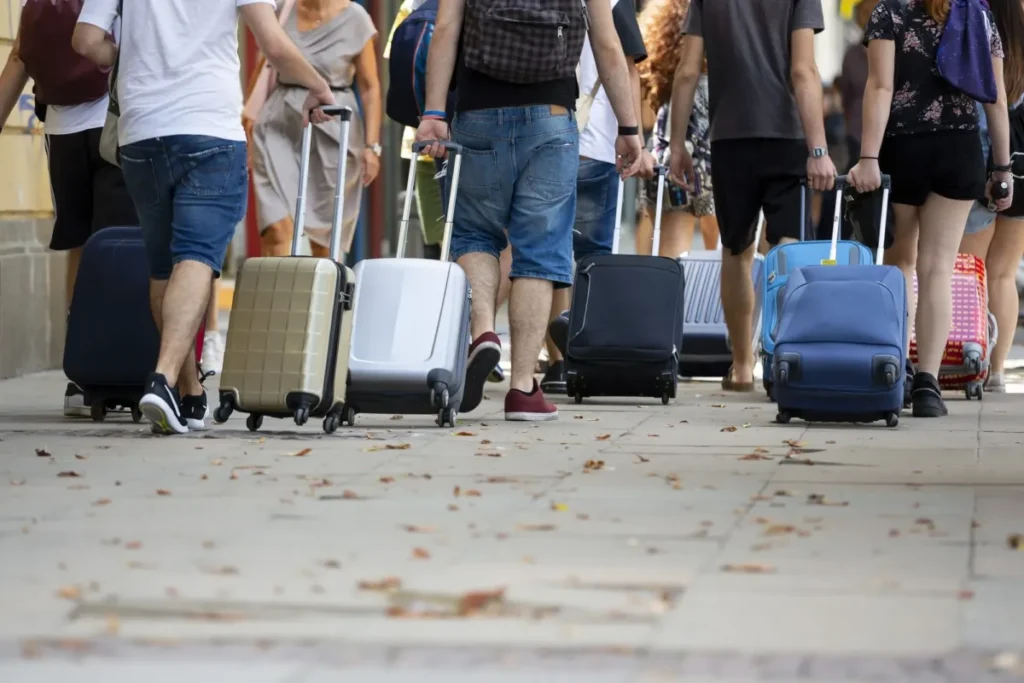
Picking the right bag is the first step to efficient packing. The right suitcase fits your stuff, meets airline rules, and makes organizing way easier.
Selecting the Best Luggage for Your Trip
Think about where you’re going and how long you’ll be gone. For a weekend trip, a carry-on or a duffel is usually enough. If you’re traveling longer, you’ll probably need a bigger checked bag.
Hardside luggage works best if you need to protect breakables or electronics. These cases usually split in half, which helps keep things organized.
Softside bags have more give and often come with handy outside pockets. They’re lighter and can expand if you really need to cram in that last souvenir.
Wheels matter! Four-wheel spinners glide in any direction and save your shoulders. Two-wheel bags are better for rougher ground, but you’ll have to pull them behind you.
Understanding Airline Size and Weight Restrictions
Airlines have their own rules for luggage size. In the US, carry-ons are usually around 22″ x 14″ x 9″, but double-check—international airlines can be stricter.
Always check your airline’s rules before you pack. If you go over, you could get hit with surprise fees or have to check your bag at the last minute.
Weight limits are a thing, too. Most airlines cap checked bags at 50 pounds, and carry-ons usually need to be under 15-22 pounds. A small luggage scale has saved me from airport surprises more than once.
Personal items (like a purse or laptop bag) count toward your carry-on allowance, but they don’t have to fit those strict size boxes.
The Benefits of Luggage with Compartments

Suitcases with compartments make life so much easier. Outside pockets are awesome for things you’ll need fast, like travel docs or a phone charger.
Inside dividers keep your clean clothes away from dirty ones. Some bags even have a separate spot for shoes, which keeps everything else clean.
Compression straps stop your clothes from sliding around and help keep wrinkles down. They also squeeze in a little more space.
Water-resistant sections are a lifesaver if you’re carrying electronics or important papers. One less thing to worry about if you spill something or get caught in the rain.
Expandable sections are great, too. You’ll have extra room for souvenirs on the way home, and you won’t need to bring another bag.
Planning What to Pack
Before you start tossing stuff in your suitcase, a little planning goes a long way. You’ll avoid that “ugh, I wish I’d packed X” feeling later.
Creating an Effective Packing List
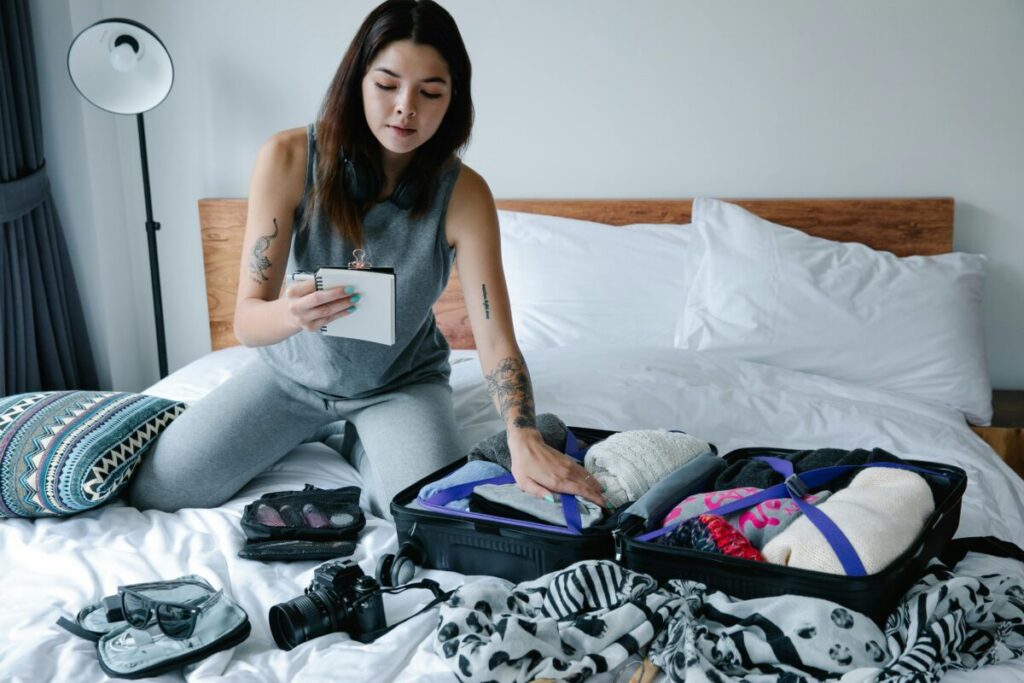
A packing list is your best defense against forgetting the essentials. I usually start mine a week before a trip and add things as I remember them. Apps like PackPoint are pretty handy—they’ll even suggest what to bring based on your plans and the weather.
Don’t just list clothes! Break it down:
- Clothing
- Toiletries
- Electronics
- Documents
- Medications
I keep a template list on my phone and tweak it for every trip. It saves so much time. Always think about the local weather and customs. That sundress might work in Hawaii, but maybe not everywhere.
Essential Packing Checklist
Here’s a basic list to get you started:
Clothing:
- Underwear and socks (one per day, plus two extras)
- Tops (short or long sleeves, depending on weather)
- Bottoms (pants, shorts, skirts)
- Pajamas
- Outerwear for the climate
Toiletries:
- Toothbrush and toothpaste
- Deodorant
- Shampoo and conditioner
- Skincare stuff
Must-haves:
- Phone and charger
- Wallet, ID, travel documents
- Medications
- Travel adapter (if you’re going abroad)
Check what your hotel or Airbnb provides. Most places have hairdryers and basic toiletries, so you can skip those and save space.
Prioritizing Must-Have Travel Items
Not everything deserves a spot in your suitcase. I’ve learned that bringing too much just means hauling around stuff you’ll never use. Start with the absolute essentials—meds, documents, electronics, and the basics.
For clothes, go for versatility. Pack things you can mix, match, dress up, or dress down. That little black dress? It works for a fancy dinner or casual exploring if you swap accessories.
Weather gear is non-negotiable. A rain jacket or tiny umbrella can be a trip-saver, even if the forecast looks fine. And don’t skimp on comfy shoes—your feet will thank you.
If you can buy it easily at your destination, don’t worry about packing it. But stuff like prescription meds? Don’t risk it—bring those from home.
Efficient Packing Techniques
Packing smart makes your trip less stressful and way more organized. The right tricks let you fit more in and keep everything easy to find.
Using Packing Cubes for Organization

Packing cubes are honestly a game-changer. They come in all sizes and keep your clothes sorted by type or even by day. I love that socks and underwear don’t get lost in the corners of my suitcase anymore.
Assign each cube a job—tops in one, bottoms in another, undies in a small one. When you get to your hotel, just pop the cubes into the drawers. Done.
If you need something, just grab the right cube—no more digging through a tornado of clothes. They also squish your stuff down a bit, so you get more space. And when TSA wants to poke through your bag, your stuff stays neat.
Rolling Clothes Versus Folding Techniques
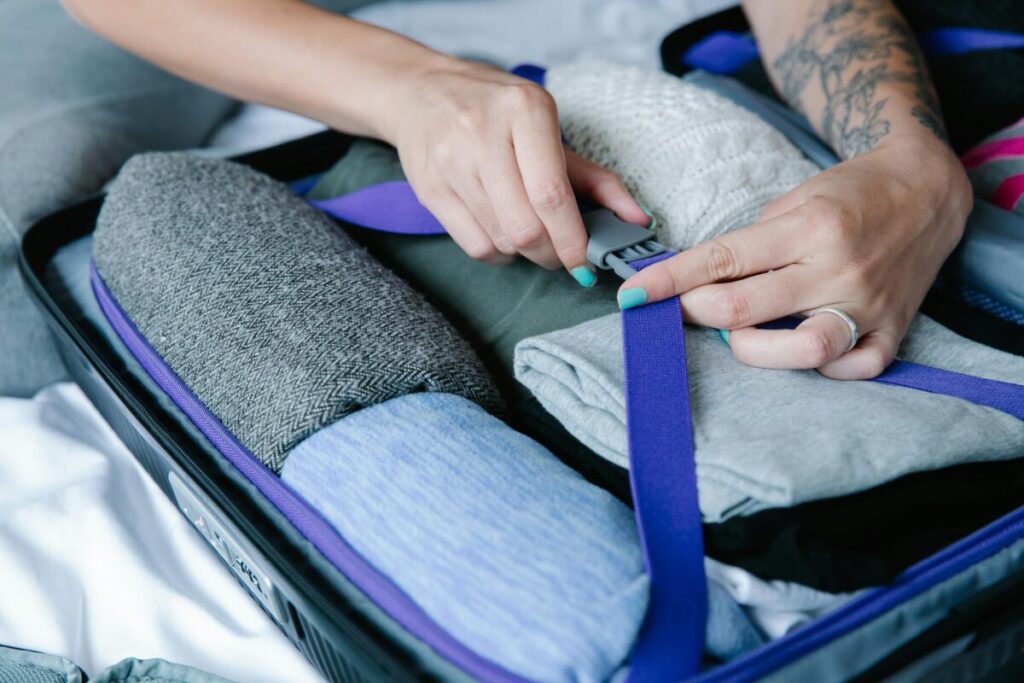
Rolling or folding? It’s the big debate. I usually roll casual stuff—t-shirts, jeans, pajamas. Rolling keeps wrinkles away and saves space by getting rid of air pockets.
For shirts and dressier stuff, folding or bundle wrapping works better. The bundle method wraps small clothes inside big ones, so you get fewer wrinkles.
Try a combo: roll your soft, casual clothes, and fold the stiff, formal pieces. Put the heavy rolled things at the bottom by the wheels, and stack lighter, folded stuff on top.
Not all fabrics are the same. Cotton and linen wrinkle easily, so rolling helps. Synthetics can handle folding just fine.
Maximizing Space with Compression Bags
Compression bags are a lifesaver for bulky clothes—think sweaters or jackets. You pack your stuff in, squeeze out the air, and suddenly there’s room for way more. I once packed three sweaters into the space for one.
Fold your clothes, pop them in the bag, seal it, and roll to push out the air. Some need a vacuum, but most just work with rolling.
Don’t overdo it, though. Compression bags can make your suitcase heavy even if everything fits. They’re also great for keeping dirty laundry separate.
Bring a couple of extras for souvenirs or laundry on the way home. Just know: your clothes might need a shake or a little steam to fluff back up after being compressed.
Choosing Neutral Colors for Versatile Outfits
Start with a neutral base—black, white, navy, tan, gray. Everything goes with everything, so you get more outfits from fewer pieces.
Three tops and three bottoms in matching colors? That’s nine outfits. Add a scarf or some jewelry for a splash of color.
Think about what you’ll actually do on your trip. One pair of shoes that works for almost everything saves a ton of space.
Plan your outfits before you pack. I take phone pics of each one so I don’t forget what goes with what. It keeps me from tossing in “just in case” extras.
Smart Packing Tips for Travelers
Efficient packing really does make your trip more fun. Here are some practical tricks to help you fit what you need—no more, no less.
Packing Light to Avoid Overpacking
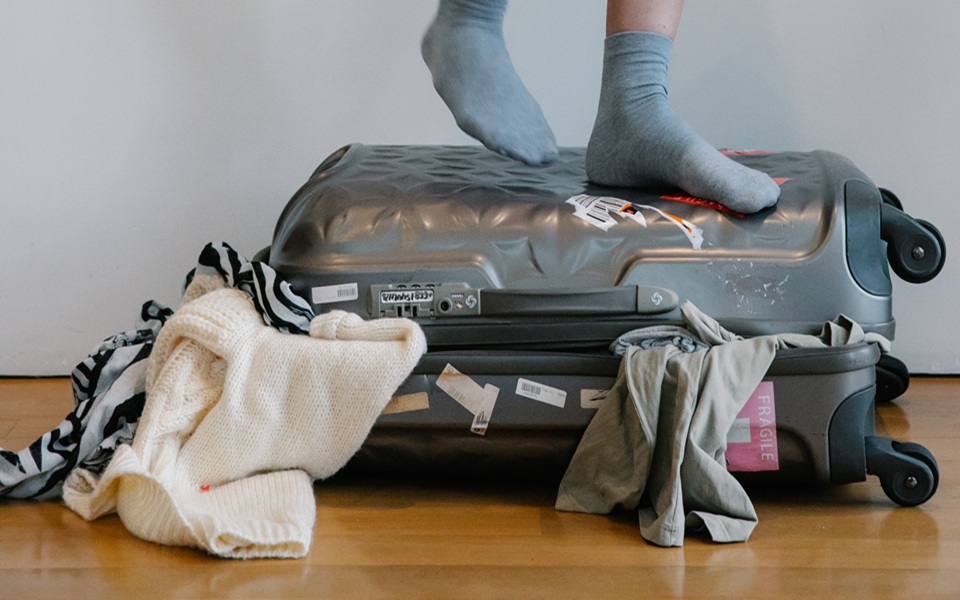
The golden rule: pack less than you think. Lay out everything, then cut a third. Trust me, most of us don’t wear half of what we bring.
For ten days, five pairs of pants or shorts and six tops you can mix and match is plenty. Rolling clothes saves space and stops wrinkles—it’s saved me more than once when I needed to squeeze in one last thing.
Pick fabrics that dry quickly and don’t wrinkle. You can wash them in a sink and they’ll be dry by morning.
Packing cubes help keep things organized and squeeze out air. I can’t imagine traveling without them now.
Leaving Room for Souvenirs
Don’t cram your suitcase full on the way out. Leave about 20-25% empty so you’ve got space for souvenirs.
If you’re planning to shop, pack things you can toss as you go—old shirts, socks, toiletries you’ll finish. I’ve brought along pajamas I was ready to toss, just for the space.
Buy flat souvenirs—postcards, bookmarks, scarves. If you pick up anything bulky, think about shipping it home instead.
Airport duty-free shops sometimes offer packaging for fragile stuff, which helps if you’re bringing back breakables.
Using Foldable Bags for Extra Storage
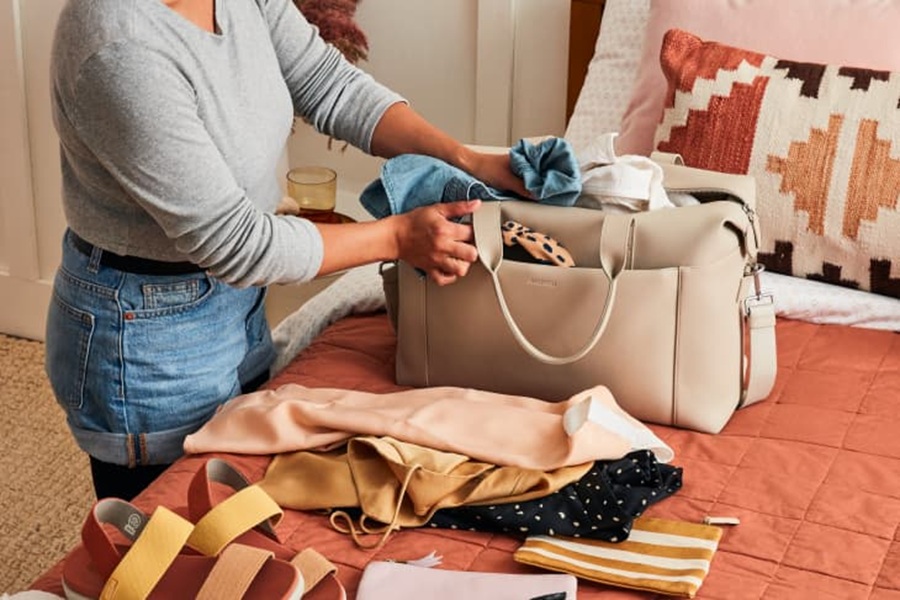
A foldable duffel bag is my secret weapon. It weighs almost nothing and takes up barely any space.
I always bring a nylon tote that folds into my palm but can hold a ton. It’s saved me from overweight baggage fees more times than I’d like to admit.
These bags are handy for beach days, groceries, or just hauling extra stuff around town.
Look for one with both hand and shoulder straps, and a zipper to keep things safe.
Organizing Your Carry-On and Personal Item
How you pack your carry-on and personal item can make your trip way smoother. When you organize them right, you’ll have everything you need on the flight and a backup if your checked bag gets lost.
Selecting Essential Items for Your Personal Bag
Your personal item is your lifeline in the air. Pick a bag that fits under the seat and has lots of pockets. I always keep my ID and passport in an easy-to-grab spot—never buried deep.
Keep these within reach: headphones, phone charger, meds, water bottle. A snack pouch saves you from overpriced airport food. Seriously, future-you will be grateful.
For long flights, I add:
- Eye mask and earplugs
- Travel pillow
- Compression socks
- Hand sanitizer
- Face wipes
I also stash a plastic grocery bag for dirty laundry or trash. It’s such a small thing, but it’s saved me more than once.
Tips for Packing a Compliant Carry-On
Plan your carry-on so you don’t get stuck at security. TSA-approved locks are worth it—they let agents open your bag without breaking anything.
Liquids are always tricky. Keep them in clear bottles under 3.4 ounces, all in a see-through zip bag. Put this at the top of your suitcase so you can grab it at security.
Sort your stuff:
- Electronics and cords in one pouch
- Toiletries in another
- Spare clothes in a packing cube
Compression cubes are magic—they save space and keep similar things together. I organize by outfit or clothing type.
Leave a little room for airport buys or last-minute souvenirs.
Day-Of Travel Packing Advice
Travel days can get chaotic, but a little prep goes a long way. Plan your travel outfit and double-check your list that morning—trust me, it’ll help you avoid forgetting something important.
Prepping Your Travel Outfit

Honestly, I always pick comfort over style when it comes to travel days, especially for long flights or endless road trips. Layers are a lifesaver—you can throw them on or peel them off as the temperature shifts.
I usually grab:
- Breathable, stretchy fabrics that resist wrinkling
- Slip-on shoes (makes airport security so much less annoying)
- Compression socks for those marathon flights
- A light jacket or cardigan with pockets—seriously, pockets are everything for boarding passes
Keep jewelry simple, or just skip it, so you don’t set off metal detectors and hold up the line. Oh, and if you’ve got bulky stuff like hiking boots, wear them instead of packing them. Trust me, you’ll thank yourself when your suitcase actually closes.
I can’t stress this enough: wear clothes with hidden or zippered pockets to keep your valuables close. Learned that lesson the hard way after a run-in with a pickpocket in Barcelona.
Final Checklist Before Leaving Home
Jot down a quick departure checklist on your phone and give it a look before you leave. It’s such a tiny thing, but it’s saved me from so many last-minute disasters.
Essential Documents:
- Passport or ID (double-check those expiration dates)
- Boarding passes
- Hotel confirmations
- Travel insurance info
Last-Minute Items:
- Charge your electronics to 100%
- Empty the fridge of anything that’ll rot
- Adjust your thermostat
- Lock up all windows and doors
- Take out the trash
Toss any medications you’ll need into your carry-on. I always pack a small “survival kit” with essentials for the first 24 hours, just in case my checked bag decides to go on its own adventure.
If you’ll be away for a while, turn off your water valves. I came home to a flooded apartment once—don’t make my mistake.
Arriving at Your Destination
Once you finally get there, what you do with your luggage matters almost as much as your packing strategy. The way you handle baggage claim and settle into your accommodation can really set the vibe for your trip.
Efficiently Navigating Baggage Claim
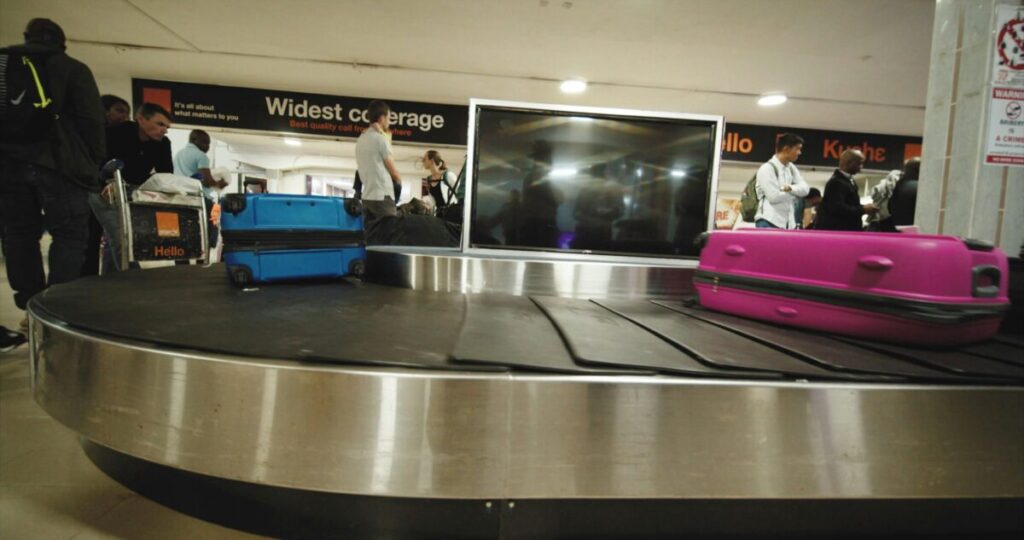
When you land, make a beeline for baggage claim—skip the coffee or restroom for now. If you packed a bright suitcase or slapped on a quirky luggage tag, you’ll spot your bag way faster. I always stand near where the bags first drop onto the carousel.
Snap a photo of your suitcase before you leave home. If it goes missing, you’ll have proof to show the airline staff.
I like to download my airline’s app for real-time carousel alerts, but you can also check the airport screens scattered around the terminal.
Honestly, if you can travel with just a carry-on, do it. Skipping baggage claim is a game changer.
Organizing Your Items Upon Arrival

When you get to your hotel or rental, unpack right away. I hang up my clothes immediately—wrinkles just sort of melt away, and I don’t have to iron.
Drawers are great for folded stuff, and I toss my toiletries in the bathroom for easy grabbing.
Completely empty your suitcase and stash it in a closet or under the bed. Living out of a jumbled suitcase? No thanks.
Pick a spot for your essentials:
- Passport and ID
- Hotel key
- Phone and charger
- Meds you need daily
- Local cash
Keep a little bag ready for daily outings—water bottle, map, sunscreen, all that. Prepping this ahead of time means you can just grab and go in the morning.
If you’re staying a while, set up a laundry bag so dirty clothes don’t mix with clean ones. Makes life easier, trust me.
Frequently Asked Questions
Packing a suitcase well isn’t just a science—it’s a bit of an art. Here are some questions I get all the time about squeezing in more stuff and keeping clothes looking decent.
What are some essential tips for maximizing space in my suitcase?
Use every bit of space you can find. Stuff socks or chargers into your shoes. Underwear fits perfectly inside bra cups and helps them keep their shape.
Roll soft clothes like t-shirts and line them along the bottom of your suitcase. That gives you a nice base to stack everything else.
Put heavier stuff near the wheels so your suitcase doesn’t topple over when you stand it up.
Can you suggest the best method for rolling clothes when packing?
Lay your shirt flat and smooth out the wrinkles. Fold in the sleeves, then roll tightly from the bottom up.
For pants, fold them in half lengthwise, then roll down from the waistband. The tighter the roll, the more space you’ll save.
Try the ranger roll if you want to go pro: fold up the bottom inch, roll from the top, and tuck the whole thing into that folded edge. It’s a little extra, but it keeps things tidy.
What’s the secret to fitting a week’s worth of clothing into a single bag?
Plan outfits that mix and match. Stick to a color scheme so you can create a bunch of looks from just a few pieces.
Lightweight, wrinkle-resistant fabrics like nylon or poly blends are your friends. They take up less space than heavy stuff like denim.
Limit yourself to three pairs of shoes, max. Wear the bulkiest ones while you travel—it really makes a difference.
How can I pack my luggage to make the most of international travel restrictions?
Check your airline’s rules before you start packing. Most international flights only allow liquids in 3.4-ounce (100ml) containers inside a clear quart bag.
Honestly, I buy toiletries at my destination when I can. It saves space and avoids leaks.
Put your toiletry bag at the top of your suitcase so you can grab it fast at security. Digging through everything at the checkpoint is the worst.
Could you advise on the ideal way to pack for a two-week trip without overpacking?
Plan to do laundry halfway through. Most hotels have laundry service, or you can usually find a laundromat nearby.
Really, just pack for a week. People almost always bring more than they need.
Packing cubes are a total game changer. I doubted them at first, but after trying them in Europe, I won’t travel without them now!
What techniques should I use to ensure everything fits in my suitcase for a flight?
Honestly, I always wear my bulkiest items on the plane. If I’ve got heavy shoes, a chunky jacket, or thick sweaters, I just put them on instead of stuffing them in my bag.
Compression bags work wonders for sweaters or jackets that just won’t shrink down. I usually grab those vacuum-sealed ones—they can shrink things by up to 80%, which feels like magic sometimes.
Whenever I can, I tuck smaller things inside others. Socks go in shoes, underwear gets stuffed into hats, and I cram little accessories into handbags. It might sound a bit chaotic, but it really does save space.

Leave a Reply